Photo Contest: Post Processing #3 [ENG/ESP]
"You're just monochrome behind all the colourful chaos."
Prarthna Amar
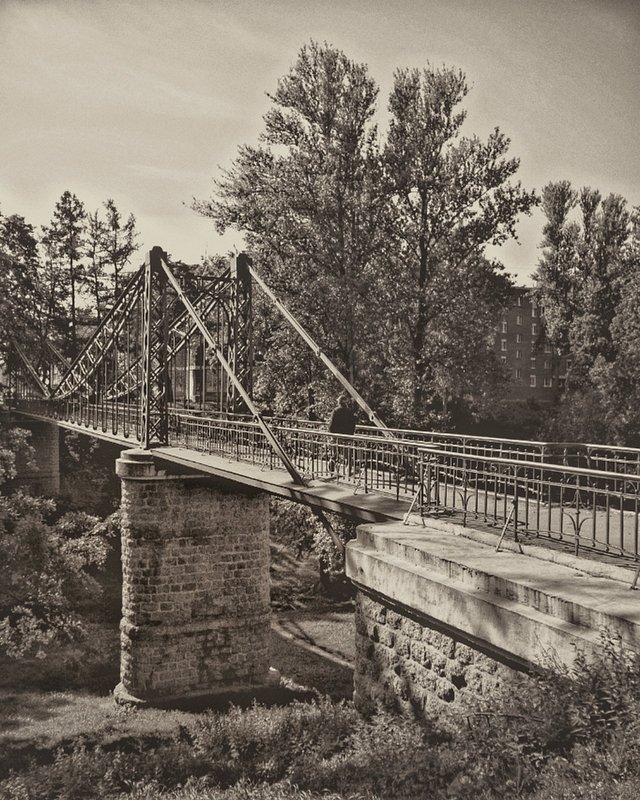
Photo Contest: Post Processing #3 [ENG/ESP]
Monochromatic photography is a photographic technique that basically consists of using a single color as a base and then modifying or adding shades, hues and tones in order to vary the amount of light present in the image.
It includes all forms of black and white photography, but it is not limited or restricted to images with these characteristics, since other tonalities such as sepia, blue or brown can also be used.
Today, it is used primarily for artistic purposes and for certain applications, rather than for visually accurate reproduction of scenes.
Strictly personally, I consider that black and white or monochromatic photography adds more emphasis and character to the images, that is to say, more personality, which sometimes is not achieved with the use of color.
In this opportunity, fellow @bambuka from the World of Xpilar Community offers us a trio of color photos from different places, which must be edited in monochrome, describing the various steps involved in the processing of the images, and then choosing one of them and explaining the reasons for our selection. A real photographic challenge that left me a great learning experience, and in which I hope to live up to what was asked of me.
Finally, as I explained in the previous post, I use the editing tools provided by the free versions of the Picsart and Snapseed applications that I downloaded some time ago, on my Samsung Galaxy A12 smartphone.
La fotografía monocromática es una técnica fotográfica que consiste básicamente en utilizar un único color como base, y posteriormente, modificar o añadir sombras, matices y tonalidades, con la finalidad de variar las cantidades de luz presentes en la imagen.
Incluye todas las formas de fotografía en blanco y negro, pero no está limitada o restringida a imágenes con estas características, ya que también pueden emplearse otras tonalidades como el sepia, el azul o el marrón.
En la actualidad, se emplea fundamentalmente con fines artísticos y para ciertas aplicaciones, más que para la reproducción visualmente precisa de escenas.
En lo estrictamente personal, considero que la fotografía en blanco y negro o monocromática, le agrega mayor énfasis y carácter a las imágenes, es decir, mayor personalidad, lo que en ocasiones no se logra con el uso del color.
En esta oportunidad, el compañero @bambuka de la Comunidad World of Xpilar nos ofrece un trío de fotos a color de diferentes lugares, las cuales deben ser editadas en monocromático, describiendo los diversos pasos involucrados en el procesamiento de las imágenes, para luego escoger una de ellas y explicar las razones de nuestra selección. Un verdadero desafío fotográfico que me dejó un gran aprendizaje, y en el que espero, estar a la altura de lo solicitado.
Finalmente, como lo expliqué en el post anterior, utilizo las herramientas de edición que proveen las versiones gratuitas de las aplicaciones Picsart y Snapseed que descargué hace ya algún tiempo, en mi teléfono móvil Samsung Galaxy A12.

Photography 1
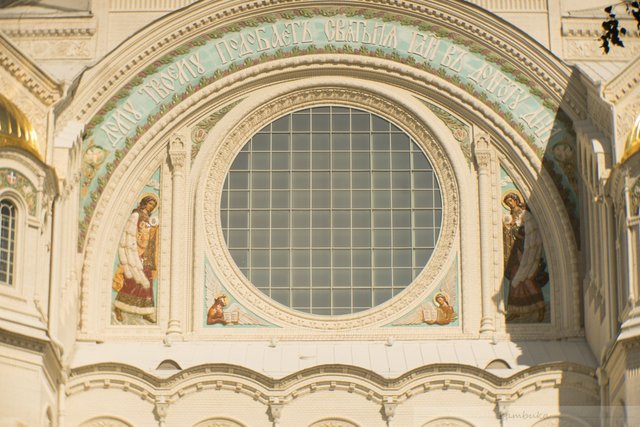
First, this image corresponding to a circular window or stained glass window of a church, I crop it with the Picsart application, maintaining the original proportion, trying to center the circumference and eliminating the elements located at the bottom, and then apply a High Dynamic Range (HDR) filter.
En primer lugar, esta imagen correspondiente a una ventana o vitral circular de una iglesia, la recorto con la aplicación Picsart, manteniendo la proporción original, procurando centrar la circunferencia y eliminando los elementos ubicados en la parte inferior, para posteriormente aplicar un filtro del tipo High Dynamic Range (HDR).
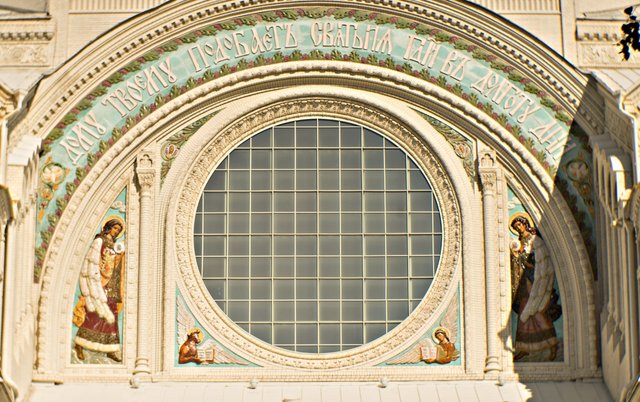
Then I go to Snapseed, where I modify the sharpness, structure, light, shadow and brightness values, before applying a black and white filter.
Again I check the previously described parameters of light, shadow and brightness, before finishing the editing work. I must clarify that my primary intention was to highlight the central circumference of the image, without sacrificing the arched inscription located at the top and the religious figures on the sides.
In this particular case, I also processed the image in a tonality closer to sepia, in order to present both below.
Luego me dirijo a Snapseed, donde modifico los valores de nitidez, estructura, luz, sombra y brillo, antes de aplicar un filtro en blanco y negro.
Nuevamente reviso los parámetros anteriormente descritos de luz, sombra y brillo, antes de dar por concluido el trabajo de edición. Debo aclarar que mi intención primordial era destacar la circunferencia central de la imagen, sin sacrificar la inscripción en arco ubicada en la parte superior y las figuras religiosas de los laterales.
En este caso en particular, también procesé la imagen en una tonalidad más cercana al sepia, con la finalidad de presentar ambas a continuación.
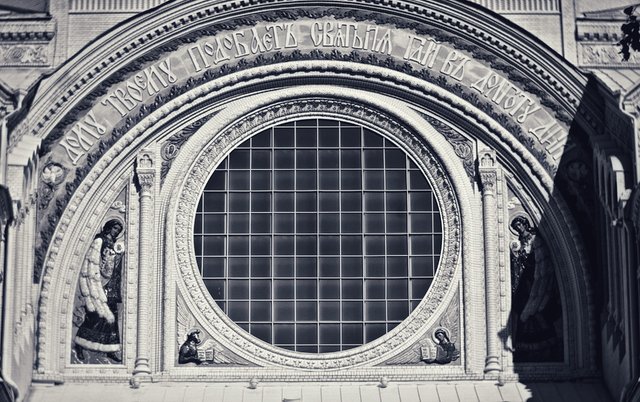
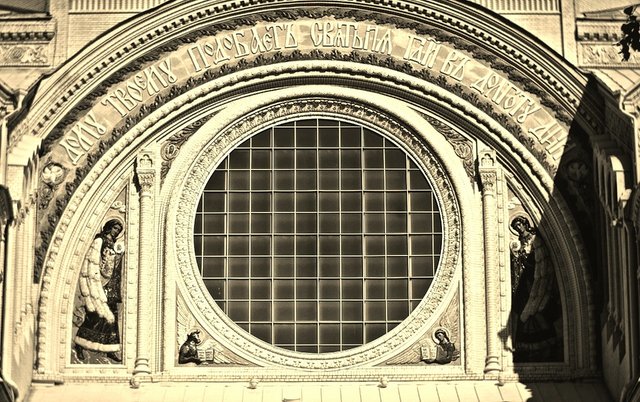

Photography 2
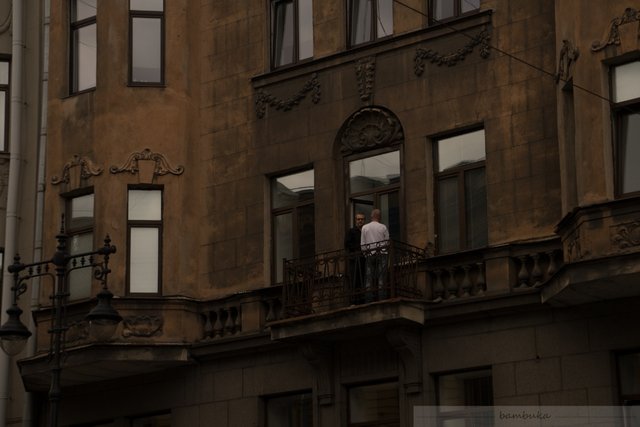
In this opportunity, the photograph presented for processing is quite dark, except for the windows that provide some light, however, the railings and ornaments are not clearly distinguishable. The central element of the image are the two people located on a small balcony, one of whom has his back to the photographer, while the other is facing the front, in addition, the image presents a slight angle with respect to the horizontal.
First, I crop the photograph to highlight the human presence. Then, I apply an HDR filter and immediately, I modify the parameters of light, shadow and brightness, among others, seeking to lighten the image as much as possible, and thus, try to give visibility to the railings, balusters and ornamental elements present in the building. Also, I slightly adjust the horizontality, around 1°, taking as a reference the lower edge of the floor on the left side of the photo.
En esta oportunidad, la fotografía que se presenta para su procesamiento, es bastante oscura, con excepción de las ventanas que le proporcionan algo de luz, sin embargo, las barandas y los ornamentos no logran distinguirse con nitidez. El elemento central de la imagen, lo constituyen las dos personas ubicadas en un pequeño balcón, uno de los cuales está de espaldas al fotógrafo, mientras el otro, se encuentra de frente, además, la imagen presenta un ligero ángulo con respecto a la horizontal.
En primer lugar, recorto la fotografía para destacar la presencia humana. Posteriormente, aplico un filtro HDR e inmediatamente, modifico los parámetros de luz, sombra y brillo, entre otros, buscando aclarar lo más posible la imagen, y de esta forma, procurar darle visibilidad a las barandas y elementos ornamentales presentes en la edificación. También, ajusto ligeramente la horizontalidad, alrededor de 1°, tomando como referente el borde inferior del piso en el extremo izquierdo de la foto.
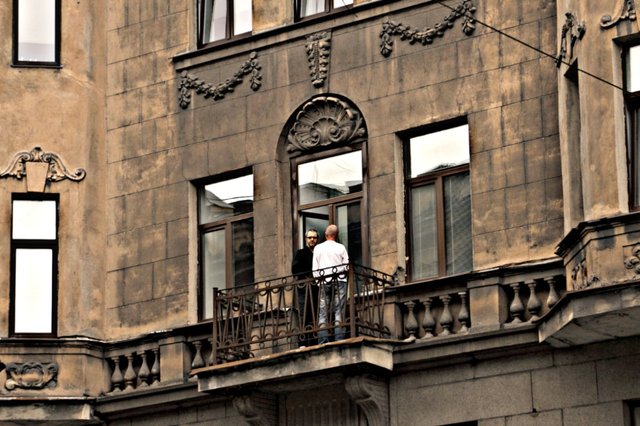
Then I apply a black and white filter in the Snapseed application and modify those parameters that are necessary to highlight the two human figures located on the balcony, and ensure that the resolution of the railings, balusters and ornaments has not been affected, resulting in the following photograph.
Luego aplico un filtro en blanco y negro en la aplicación Snapseed y modifico aquellos parámetros que sean necesarios para destacar las dos figuras humanas ubicadas en el balcón, y asegurar que la resolución de las barandas, balaustres y ornamentos no se haya visto afectada, dando como resultado la siguiente fotografía.
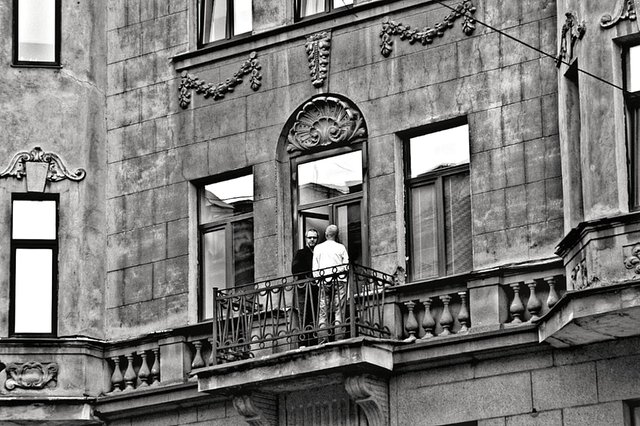

Photography 3
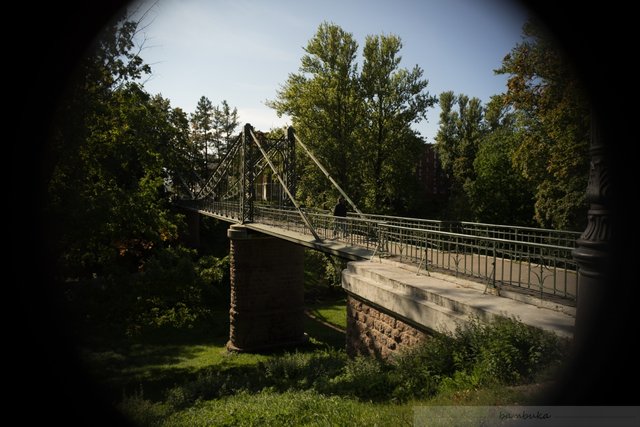
Finally, we have a photograph of a bridge or pedestrian overpass, although at first I could not identify it as such, but I thought it was a railroad or motor vehicle overpass.
The image, like the previous ones, is dark and does not present variations in the intensity of light, but with the difference that it has areas of total darkness on its sides, as if it were a "Stamp" type filter, similar to the one offered by the Picsart application within its range of free filters.
At first, I try to clarify the image by applying various filters and modifying the values of light, shadow, brightness and contrast, without obtaining a satisfactory result, seeing the need to undo the changes repeatedly, as I described in the previous post, where I explained that this was a process of trial and error, and where emotionality plays a major role in photo editing, sometimes in greater proportion than rationality, at least in my particular case.
At a given moment, I managed to find a filter called "INDIE1" and after adjusting the blur volume, I managed to obtain an image that in a certain way reminds me of a spring print, and where the elements present in the graphic composition can be perceived at sight.
Then I proceed to crop the image, trying to keep the proportion of the original photo, however, I can not get a result that I can consider satisfactory, so I decide to use a 4:5 proportion usually reserved for portraits, obtaining a color image that I found very attractive.
Por último, tenemos una fotografía de un puente o paso peatonal elevado, aunque en un primer instante no pude identificarlo como tal, sinó que pensé que se trataba de una vía ferroviaria o para el tránsito de vehículos automotores.
La imagen, al igual que las anteriores, es oscura y no presenta variaciones en la intensidad de la luz, pero con la diferencia que posee zonas de oscuridad total en sus laterales, como si se tratase de un filtro tipo "Estampa", similar al que ofrece la aplicación Picsart dentro de su gama de filtros gratuitos.
En un primer momento, procuro aclarar la imagen aplicando diversos filtros y modificando los valores de luz, sombra, brillo y contraste; sin obtener un resultado satisfactorio, viéndome en la necesidad de deshacer los cambios en repetidas ocasiones, tal como lo describí en el post anterior, donde expliqué que este era un proceso de ensayo y error, y donde la emocionalidad juega un papel preponderante en la edición fotográfica, a veces, en mayor proporción que la racionalidad, al menos en mi caso en particular.
En un momento dado, logro dar con un filtro denominado "INDIE1" y luego de ajustar el volúmen de difuminado, logro obtener una imagen de que cierta manera me recuerda una estampa primaveral, y donde los elementos presentes en la composición gráfica, logran ser percibidos a la vista.
Luego procedo a recortar la imagen, procurando mantener la proporción de la foto original, sin embargo, no logro obtener un resultado que pueda considerar satisfactorio, por lo que decido emplear una proporción 4:5 usualmente reservada para retratos, obteniendo una imagen a color que me resultó muy atractiva.
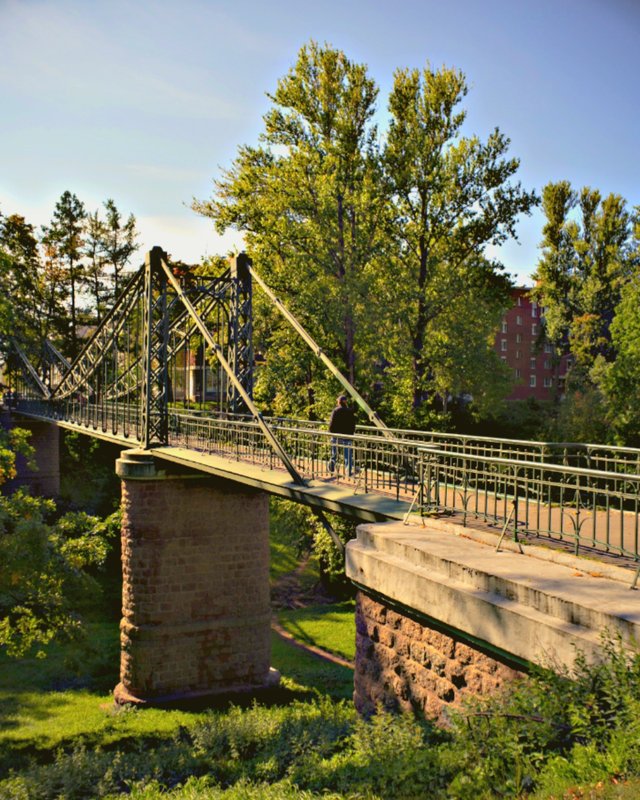
I apply a black and white filter, and proceed to rectify the contrast, brightness, light and shadow volumes, obtaining the following result.
Aplico un filtro blanco y negro, y procedo a rectificar los volúmenes de contraste, brillo, luz y sombra, obteniendo el siguiente resultado.
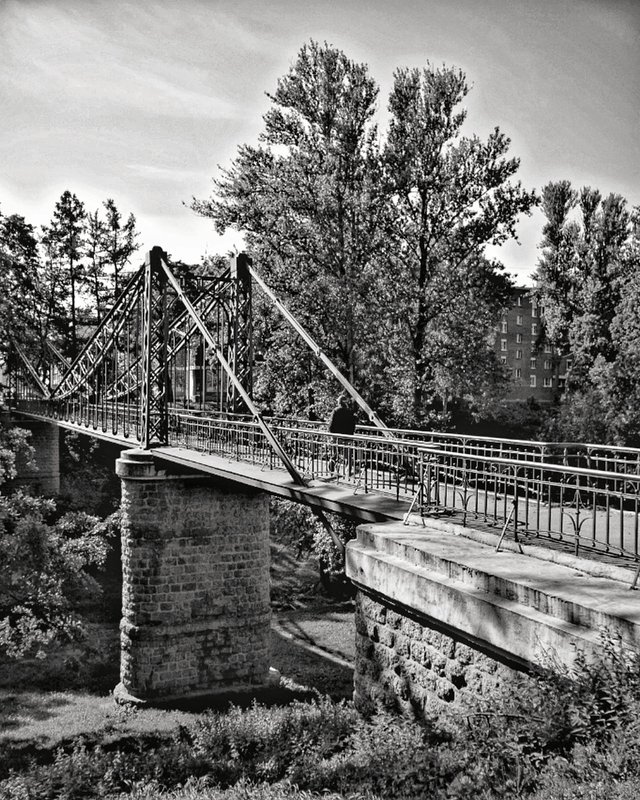
However, I decide to go further, and to the spring image in "Portrait" format, I decide to apply a sepia filter, and after adjusting the volumes of brightness, contrast, light, shadow, hue and blur; I get a result that, at least in my humble opinion, looks great, as if it were an old photograph rescued from some old and forgotten trunk of memories.
I must confess that this image awakened in me, a feeling of nostalgia for a past that I evidently did not know, besides, at first sight, it looks like an old photo taken at the end of the XIX Century or the beginning of the XX Century, when probably this suspension bridge could have been built or modified judging by the iron work of its constituent elements, and the masonry work of its support base, although the building hidden among the vegetation on the right, seems to be of more recent date, perhaps from the decade of the 50s or 60s.
For all the above reasons, I took the risky decision to choose this editing work to submit to the contest, without knowing for sure if I made the right decision or not.
Sin embargo, decido ir más allá, y a la imagen primaveral en formato "Retrato", decido aplicarle un filtro sepia, y luego de ajustar los volúmenes de brillo, contraste, luz, sombra, matiz y difuminado; obtengo un resultado que, al menos en mi humilde opinión, luce grandioso, como si se tratase de una antigua fotografía rescatada de algún viejo y olvidado baúl de recuerdos.
Debo confesar que esta imagen despertó en mí, una sensación de nostalgia por un pasado que evidentemente no conocí, además, a primera vista, pareciera una vieja foto tomada a finales del Siglo XIX o principios del Siglo XX, cuando probablemente este puente colgante pudo haber sido construído o modificado a juzgar por el trabajo de hierro de sus elementos constituyentes, y el trabajo de mampostería de su base de soporte, a pesar de que la edificación oculta entre la vegetación a la derecha, pareciera ser de data más reciente, tal vez de la década de los años 50 o 60.
Por todas las razones anteriores, tomé la arriesgada decisión de escoger estre trabajo de edición para presentarlo al concurso, sin saber a ciencia cierta, si tomé o no la decisión correcta.



Thank you, friend!


I'm @steem.history, who is steem witness.
Thank you for witnessvoting for me.
please click it!
(Go to https://steemit.com/~witnesses and type fbslo at the bottom of the page)
The weight is reduced because of the lack of Voting Power. If you vote for me as a witness, you can get my little vote.
twitter-promotion
Upvoted! Thank you for supporting witness @jswit.
I agree. Moving away from the color, we get a more accurate idea of the object.
I like the sepia version more. It echoes the original in tone, but loses distracting colors.
There is one feature here when leveling the "horizon line".
The picture was taken when the camera was not parallel to the wall of the building. In this case, all horizontal lines will be inclined and they cannot be taken as a guide for leveling.
In these cases, there can be only one landmark - the vertical in the center of the frame. Parallel to this vertical, the nearest vertical of the photo should be oriented.
In your case, it turned out that the house tilted to the left)
In my opinion, there is not enough work on the composition.
The upper line of windows distracts from people, and the left part also draws attention to itself and introduces an imbalance (it seems too heavy)..
In my opinion, you have chosen the right solution :)
I like the format and the chosen composition.
Excessive yellowness of the color variant and reduced "whites" gave a good aging result.
Your post is manually rewarded by the
World of Xpilar Community Curation Trail
STEEM AUTO OPERATED AND MAINTAINED BY XPILAR TEAM
https://steemit.com/~witnesses vote xpilar.witness